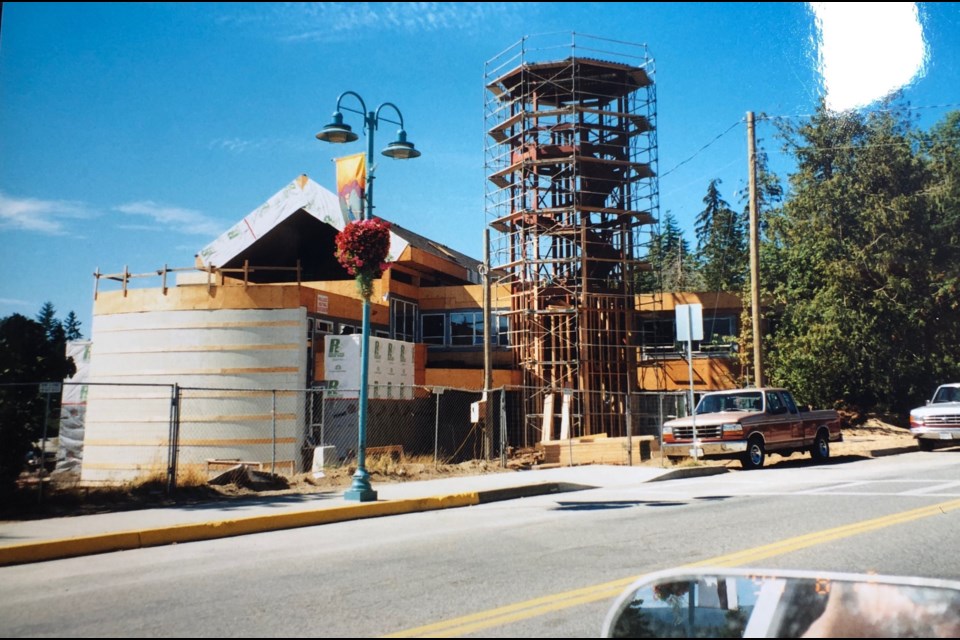The fate of Sechelt’s iconic tower was once again up for debate June 26, at a committee of the whole, where staff discussed future phases of the municipal hall remediation.
The nautical-themed tower has been closed to the public for several years due to water leaks and damage. The district mainly uses the tower by lighting it in different colours, often representing a group or organization’s special event.
Kirn Dhillon, Sechelt director of engineering and operations, said the municipal hall cost $3 million when it was built in 1995, during what is known as the “leaky condo era” of construction in B.C., which is the root of many of the issues the hall now faces.
Over the building’s 30-year life, the growth of the surrounding community and the array of services that the district offers have begun to exceed what the hall can support. This was confirmed in a Cornerstone Consultants needs assessment and a Tony Osborn Architecture and Design (TOAD) report on the library, Dhillon said.
Dhillon said the meeting’s main objective was to eliminate two of the proposed remediation options and that staff are hoping a final option is chosen before July 17.
The options
Julie Maerz, Sechelt engineering project manager, provided a summary of the four options for the tower.
Option A, the status quo, would be the minimal required upgrade, removing the building envelopes and replacing them how they were, keeping the tower and surrounding walls, budgeted at $950,000.
Option B, the interim stop gap, would remove the tower and add a small expansion in its place, budgeted at $3.85 million.
Option C, the generational vision, is a “significant, high-level” example of what an expansion of the hall and library could look like, budgeted at $18.5 million.
Option D, pause and plan, which includes the tower and adjacent walls remediation and includes the district looking at other options, including a feasibility study and community engagement and other points that arose from the needs assessment report, would cost $950,000 from Option A, plus an additional $100,000.
State of the tower
William Tran, project engineer at SR Engineering Ltd, said their report found air leakage and various degrees of moisture had occurred through the building envelope, with water stains and moisture content in the low 20 percentages, where decay occurs from the growth of fungi.
Tran explained Sechelt's warm and wet climate means that the wetting exposure of this building is high and drying potential is low, saying that managing moisture is essential.
Speaking to the tower walls, Tran said they found “failure mechanisms” such as insufficient detailing, failed sealant, holes and siding, seal penetrations and other damage. The system cannot manage the additional moisture loads, resulting in deterioration.
These issues are known as the “leaky condo crises,” Tran added.
The aluminum frame assemblies and the small joint sealants, gaskets and glazing tapes of the windows are reaching their service life or failing systemically.
Inadequate moisture protection has also caused similar damage to occur on the roof of the tower.
Tran said that when issues are this numerous ongoing, short-term maintenance isn't practical.
“There is significant benefit for preventive rather than reactionary measures,” Tran said, prefacing that repair costs significantly rise as deterioration increases.
Coun. Adam Shepherd said council was really making two decisions, both what to do immediately and how to accommodate the two uses of the space for the next 20 years, adding that he was against option B as it is a high cost for a small amount of space.
Given the scope of the project, Coun. Dianne McLauchlan asked if staff could explore if the SCRD would be interested in contributing to capital funding.
Reiterating that the purpose of the meeting was to eliminate two proposed options, Dhillon said information on funding would come following a discussion with Sechelt’s finance department later in the planning stage, adding that potential funding opportunities were included in the report.
Prefacing that he is opposed to spending $18 million, Coun. Alton Toth spoke in support of Option D, saying that if council is going to do the tower work, they should kick in some extra money to speak the the community.
“I think for the $100,000, we get a lot of conversation with the community about what they would like to see what they would be willing to pay for, and what future options might be available for everybody,” he said.
Mayor John Henderson asked what the implications would be if council did nothing for the next two winters, asking if it would become a safety issue.
Saying that it would be a “costly choice,” Tran explained the report found the conditions of the tower will continue to degrade. He said the longer council waits, the higher the cost and risk of increased damage will rise.
Agreeing that hearing from the public is paramount, council members said that further consultation with the community was needed, council directed staff move forward with Option D and requested that details on the longevity of the tower be included in the staff report.
Jordan Copp is the Coast Reporter’s civic and Indigenous affairs reporter. This reporting beat is made possible by the Local Journalism Initiative.




